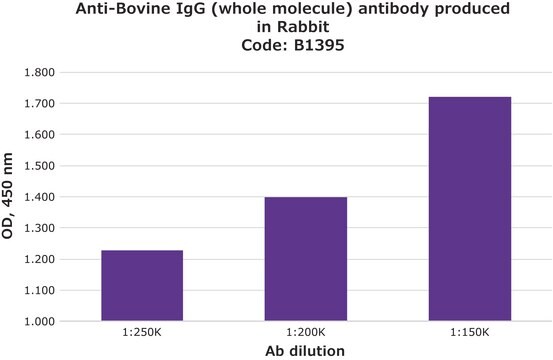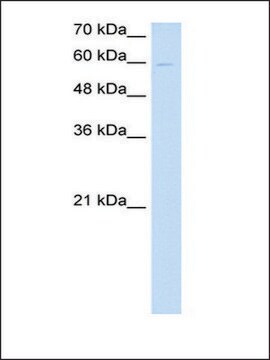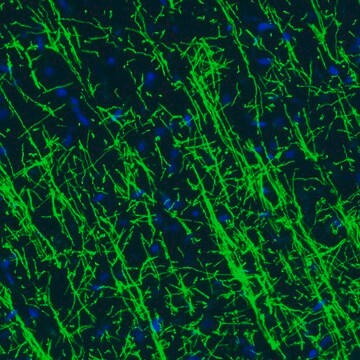추천 제품
생물학적 소스
rabbit
결합
unconjugated
항체 형태
affinity isolated antibody
항체 생산 유형
primary antibodies
클론
polyclonal
형태
buffered aqueous solution
분자량
34 kDa
종 반응성
human
농도
0.5 mg - 1 mg/mL
기술
immunohistochemistry: suitable
western blot: suitable
NCBI 수납 번호
UniProt 수납 번호
배송 상태
wet ice
저장 온도
−20°C
타겟 번역 후 변형
unmodified
유전자 정보
human ... APOE(348)
일반 설명
APOE gene encodes for Apolipoprotein E, a main apoprotein of the chylomicron. ApoE is a 299 amino acid containing plasma protein with a molecular weight of 34kDa. It is synthesized primarily in liver and is mapped on to chromosome 19 in a cluster with APOC1 and APOC2.
면역원
Synthetic peptide directed towards the N terminal region of human APOE
애플리케이션
Anti-APOE antibody produced in rabbit is suitable for western blotting at a concentration of 1μg/mL.
생화학적/생리학적 작용
ApoE binds to its specific receptor and mediates the transport of lipid and cholesterol, ligands for the low-density lipoprotein (LDL) and very low density lipoprotein (VLDL) receptors, through the bloodstream. It is also involved in repair mechanism against tissue injury. For example, increased amounts of apolipoprotein E are present at peripheral nerve injury and regeneration site. Mutation in APOE gene leads to familial dysbetalipoproteinemia, or type III hyperlipoproteinemia (HLP III), in which increased plasma cholesterol and triglycerides results in impaired clearance of chylomicron and VLDL remnant.
서열
Synthetic peptide located within the following region: KVLWAALLVTFLAGCQAKVEQAVETEPEPELRQQTEWQSGQRWELALGRF
물리적 형태
Purified antibody supplied in 1x PBS buffer with 0.09% (w/v) sodium azide and 2% sucrose.
면책조항
Unless otherwise stated in our catalog or other company documentation accompanying the product(s), our products are intended for research use only and are not to be used for any other purpose, which includes but is not limited to, unauthorized commercial uses, in vitro diagnostic uses, ex vivo or in vivo therapeutic uses or any type of consumption or application to humans or animals.
적합한 제품을 찾을 수 없으신가요?
당사의 제품 선택기 도구.을(를) 시도해 보세요.
Storage Class Code
12 - Non Combustible Liquids
WGK
WGK 3
Flash Point (°F)
Not applicable
Flash Point (°C)
Not applicable
시험 성적서(COA)
제품의 로트/배치 번호를 입력하여 시험 성적서(COA)을 검색하십시오. 로트 및 배치 번호는 제품 라벨에 있는 ‘로트’ 또는 ‘배치’라는 용어 뒤에서 찾을 수 있습니다.
W A Groenewegen et al.
Arteriosclerosis and thrombosis : a journal of vascular biology, 14(11), 1695-1704 (1994-11-01)
We identified the first insertion mutation that specifies an apolipoprotein (apo)B truncation, apoB-70.5, in a father and son with hypobetalipoproteinemia (total and low-density lipoprotein [LDL] cholesterol < 5th percentile, plasma apoB levels approximately one third of normal). The mutation is
R W Mahley
Science (New York, N.Y.), 240(4852), 622-630 (1988-04-29)
Apolipoprotein E is a plasma protein that serves as a ligand for low density lipoprotein receptors and, through its interaction with these receptors, participates in the transport of cholesterol and other lipids among various cells of the body. A mutant
María Solanas-Barca et al.
Atherosclerosis, 222(2), 449-455 (2012-04-07)
Rare mutations in the APOE gene, undetectable with the usual genotyping technique, are responsible for dominant familial dysbetalipoproteinemia (FD) and therefore could be easily misclassified as familial combined hyperlipidemia (FCHL). We aimed to identify APOE mutations associated with dominant combined
Y K Paik et al.
Proceedings of the National Academy of Sciences of the United States of America, 82(10), 3445-3449 (1985-05-01)
The gene for human apolipoprotein E (apo-E) was selected from a library of cloned genomic DNA by screening with a specific cDNA hybridization probe, and its structure was characterized. The complete nucleotide sequence of the gene as well as 856
Barbara Castella et al.
Nature communications, 8, 15663-15663 (2017-06-06)
Vγ9Vδ2 T cells are activated by phosphoantigens, such as isopentenyl pyrophosphate (IPP), which is generated in the mevalonate pathway of antigen-presenting cells. IPP is released in the extracellular microenvironment via unknown mechanisms. Here we show that the ATP-binding cassette transporter
자사의 과학자팀은 생명 과학, 재료 과학, 화학 합성, 크로마토그래피, 분석 및 기타 많은 영역을 포함한 모든 과학 분야에 경험이 있습니다..
고객지원팀으로 연락바랍니다.






